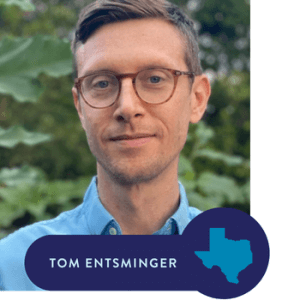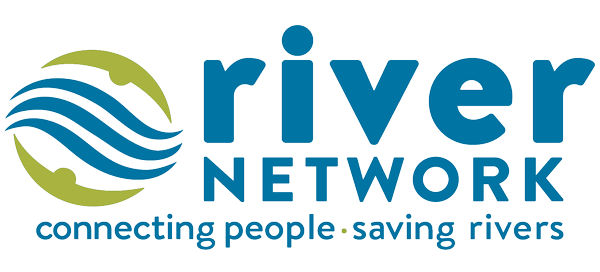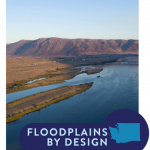Lessons from the Network: Tom Entsminger
Tom is the Policy Director at The National Wildlife Federation (NWF). NWF brings together water  policy, science, and education experts to build a future with fresh water for every living thing.
policy, science, and education experts to build a future with fresh water for every living thing.
This interview was conducted on July 26, 2024 – Before the finalization of the State Flood Plan. It has been lightly edited for clarity and brevity.
River Network (RN): To get started, can you give me a brief introduction to who you are and your role at National Wildlife Federation (NWF)?
Tom Entsminger (TE): I am the Policy Director for National Wildlife Foundation’s Texas Coast & Water program. We do advocacy and collaborative work with other conservation organizations in the area for sensible water policy and equitable distribution of funds, reduction of water loss, responsible planning, planning within our water footprint. In a state like Texas that’s affixed on growth and economic development, we try to maintain a consistent voice for conservation and clean water. My role here is to help build and manage coalitions of advocates, as well as identify policy positions that we can communicate to the State Capitol, to legislators and their staff, and to the public. Previously, I spent about 14 years in state government working initially on the Texas CDBG [HUD’s Community Development Block Grant] program before going to the Texas Water Development Board (TWDB), which manages the Texas Flood Infrastructure Fund (FIF).
RN: Where does the NWF focus its policy advocacy?
TE: The Texas Coast and Water Team focuses mostly on state-level advocacy, though many of the related issues sit at a unique confluence between local, regional, state, and federal concerns. We spend a lot of time on research and issue framing to support effective advocacy on water issues, often in collaboration with other NGO’s and community based organizations.
RN: How does Texas fund flood and specifically green stormwater infrastructure?
TE: Texas’ SRF programs are the primary funding source. The Texas Water Development Board also administers several state-funded programs, including the Texas Water Development Fund (DFund), a long-standing program supported by state General Obligation bonds that is able to support flood mitigation infrastructure (including green projects).
In 2019, Texas voters approved creation and funding of the Flood Infrastructure Fund (FIF). The initial funding allocation came from Texas’ Economic Stabilization Fund and a second allocation was approved in 2023, but FIF resembles other TWDB programs that are financed using other methods so it may continue to change over time. The TWDB was also given the responsibility of issuing a State Flood Plan which recommends strategies that will become the projects eligible for FIF assistance. The first Texas State Flood Plan was completed in September 2024, and will be updated on a 5-year cycle which begins with the development of Regional Flood Plans by regional planning groups across the state. Green projects recommended through the flood planning process will be eligible for FIF funding.
RN: What was the impetus behind Texas’ Flood Infrastructure Fund? What were the primary drivers for this policy?
TE: Texas experienced numerous rain- and flood-related disasters over the past decade, but the severe impact of Hurricane Harvey in 2018 was still fresh in many Texans’ minds during the 2019 legislative session. The recovery from Harvey was a very long and slow process, so even during the legislative session, the impacts of the storm were visible in everybody’s backyards. A lot of the legislators were very personally impacted. That resulted in broad, joint bipartisan support. There wasn’t a lot of debate about it, but there was questioning of what it might look like. In the end the legislation didn’t go into tremendous detail about what it should look like and a lot of decision making was left to the agency.
RN: How did you successfully advocate for this policy change? How long did it take? What strategies and tactics did you use? Where did support for the policy come from?
TE: Funding for flood mitigation carried broad bipartisan support throughout the legislative session. The appropriation of funds for flood mitigation felt like a foregone conclusion, and many policy issues were set aside to be resolved during the new program’s implementation. The TWDB held meetings across the state to take public input to develop agency policies around issues such as the prioritization of projects and geographic distribution of funds. A diverse audience of communities, consulting engineers, and water utilities participated in these meetings and were instrumental in shaping the FIF program in its first year.
RN: What have been the biggest hurdles or challenges related to green stormwater infrastructure funding in Texas?
TE: There is a general lack of awareness about green project alternatives and their potential benefits. Community decision-makers are often thankful when engineers propose solutions to infrastructure needs and are not asking what about alternatives or opportunities for broader public benefits. Additionally, the TWDB encourages but does not prioritize green projects and does not invest in outreach or technical assistance in this area. There’s a lot of room for increased focus on nature-based solutions in Texas. When the Flood Infrastructure Fund came along there were a lot of questions on how much the bill was going to emphasize nature-based solutions. We ended up with this program that can support different kinds of projects, including nature-based solutions, but none of them are called out or well prioritized within the law. Now state employees have the responsibility of trying to figure out how to apply it.
RN: Was there opposition to the adoption of the FIF? If so, how was it diffused/overcome?
TE: The program was very popular and the ballot measure passed with 77.87% of voters in support. This was seen as a huge opportunity for private sector companies and environmental organizations. TWDB received comments from the Sierra Club, as well as the Concrete Manufacturers Association. It was really informative and interesting to learn about people’s concerns and potential environmental versus economic impacts. There were concerns that one group or one area would run off with all the money, so the goal was to design a program where we wouldn’t give the money away to any one group, and I think we accomplished that.
RN: What organizations have you partnered and built effective coalitions with? How did you build trust, designate roles and responsibilities, and successfully come together?
TE: It was a really interesting process. We had no idea what this program was supposed to look like. The legislators just told us to get it done, spend the money, don’t embarrass us. We scheduled a couple of dozen meetings in different cities. As a TWDB staff member, my role was to travel across Texas and explain the issues that would be left up to TWDB policy and hold discussions that helped inform how we would structure the program. For example, we talked about the ways that public agencies prioritize projects and seek to distribute funds equitably. Do you prioritize low-income areas?areas. Do you prioritize areas with historic flood impacts? Do you go purely by flood risk modeling? Or do you combine them? These were the kinds of conversations we had with the public so that they weren’t surprised later, but also so that we could use their input to inform our own work. NWF collaborated with organizations like the Sierra Club, the Galveston Bay Foundation and The Nature Conservancy. They banded together to create the Texas Living Waters Project to amplify their voice on priority recommendations. At the time, I did notice that amplified voice in the comment letters after that coalition was built. We also saw a lot of ground-level, smaller coalitions that came together for the purpose of this opportunity. Anecdotally, some of the most important input I received was from the NWF and its partner organizations, who suggested using the Social Vulnerability Index as a criterion to prioritize projects. Staff at the TWDB were previously unfamiliar with this metric, but we ended up using it after staff latched on to the idea and advocated for it within the agency.
RN: Can you describe what implementation has looked like so far? Are you continuing to work with affected communities and/or state agencies to make sure regulation is being well implemented?
TE: Implementation of the first two rounds of FIF assistance has been very successful by many metrics. Going forward, project eligibility will be tied directly to the recommendations in the State Flood Plan, similar to the way Texas funds water supply projects recommended in its State Water Plan. The method for funding the program will probably change; one-time transfers from the Economic Stabilization Fund may be replaced by a GO [General Operating] or Revenue bond program, again similar to the way water supply projects are funded.
In collaboration with [coastal] organizations, particularly in Houston and Galveston, NWF submitted comments on the draft Intended Use Plan for the FIF for this round. The Plan explains how they intend to use the funds and includes ranked project lists. It’s a really good opportunity to comment on implementation. TWDB has kept the Social Vulnerability Index, which is pretty cool. They’re also starting to consider using it in other programs, which is also really cool. A lot of the funding we’re going to see over the next couple of years is for planning studies. We’re broadly in support of the way they’ve been spending the money so far. Over time we hope to interface with regional planning groups and make sure that they’re taking a hard look at green infrastructure.
RN: What policy issues are a current priority for the NWF and how are you advancing your goals?
TE: Through the Texas Living Waters Project, the NWF collaborates with other conservation organizations active in Texas to advocate for sensible water policy to support water conservation and the equitable distribution of funds. A lot of it revolves around green infrastructure and nature-based solutions and the nexus between water and wastewater. We’re promoting One Water and [water] reuse. In addition, water loss is an enormous issue in Texas. We are working to get communities to recognize the issue and pursue funding to resolve it. We also work on equitable distribution of funds to disadvantaged communities through the SRF programs and limited public financial assistance.
RN: What are you most proud of?
TE: I look back on my FIF experience with pride, since so many questions remained unanswered when voters went to the polls and we (the TWDB) did an admirable task of structuring a program that would successfully allocate the money to worthy projects, setting the stage for further investment in the future. I was personally responsible for drafting our first FIF Intended Use Plan starting with a blank page, and it makes me feel proud to know I contributed in some small way to a piece of our state’s history.






